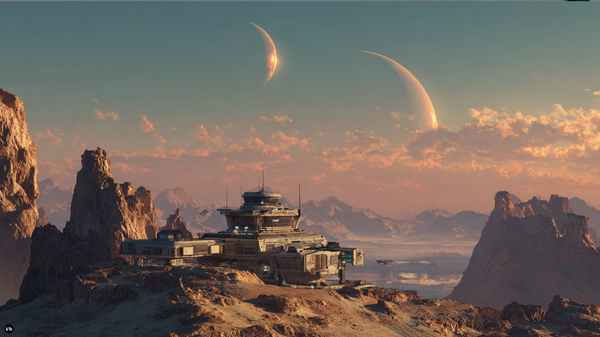The Foundation Series Blog (Part 1): Psychohistory and the Fall of the Galactic Empire

Introduction: An Immortal Monument in Science Fiction Literature
In the vast galaxy of science fiction literature, Isaac Asimov's Foundation series shines like a brilliant star, illuminating the imaginative worlds of countless readers. This epic masterpiece spanning thousands of years of history and covering the entire galaxy not only redefined the narrative style of space opera but also became one of the most influential works in science fiction with its profound insights into the evolution of human civilization.
The Foundation series was originally serialized as short stories in Astounding Science Fiction magazine from 1942 to 1950, and was later compiled into a trilogy: Foundation, Foundation and Empire, and Second Foundation. In 1966, this trilogy defeated The Lord of the Rings at the World Science Fiction Convention to win the "Hugo Award for Best All-Time Series"—the only time in the award's history that it was given to a series, demonstrating its supreme status.
Creative Background: From the Roman Empire to the Galactic Empire
Asimov's inspiration for creating the Foundation series came from Edward Gibbon's historical masterpiece The History of the Decline and Fall of the Roman Empire. In 1941, the 21-year-old Asimov was discussing story ideas with editor John W. Campbell on the New York subway when Campbell suggested he project the rise and fall of the Roman Empire onto a future galactic empire. This suggestion ignited Asimov's creative passion.
Asimov ingeniously merged history, sociology, psychology, and mathematics to construct a grand narrative framework spanning millennia. He focused not on individual heroes' adventures but on the evolution of entire civilizations as the protagonist—an unprecedented innovation in science fiction at the time. The Foundation series pioneered the "Future History" writing tradition, profoundly influencing later science fiction works, from Dune to Star Wars, all bearing its imprint.
Psychohistory: The Mathematics of Predicting Civilization
The most core concept of the Foundation series is "psychohistory"—a fictional discipline combining history, sociology, statistics, and mathematics that can predict the future behavior of large populations.
Basic Principles of Psychohistory
Psychohistory was founded by mathematician Hari Seldon and is built on several key assumptions:
- Law of Large Numbers: While individual behavior is unpredictable, when the sample size is sufficiently large (such as trillions across the entire galaxy), group behavior exhibits predictable statistical patterns.
- Historical Inevitability: On a macro scale, social development follows trends that can be described by mathematical models, just as the random motion of gas molecules ultimately obeys thermodynamic laws.
- Condition of Ignorance: Psychohistory's predictions must remain secret from the subjects being studied. Once people know the prophecy, their behavior changes, invalidating the prediction—a manifestation of the "uncertainty principle" in social science.
Limitations of Psychohistory
Asimov was no blind technological optimist. He clearly pointed out the limitations of psychohistory in his work: it can only predict overall trends of large groups, not individual behavior; it fails when facing extraordinary individuals like "the Mule"; it requires humanity to remain within certain technological and social development levels to be effective.
This sober recognition of scientific limitations precisely reflects Asimov's profound insight as both scientist and writer. Psychohistory is neither an omnipotent crystal ball nor simple pseudoscience, but a thought experiment that makes us ponder: How much of social development is necessity versus chance?
The Galactic Empire: Glory and Decline
The story begins in the distant future of the Galactic Era. Humanity has colonized the entire galaxy, establishing a Galactic Empire ruling twenty-five million inhabited planets. The Empire's capital, Trantor, is a completely urbanized planet covered in steel buildings, housing forty billion people, serving as the political, cultural, and administrative center of galactic civilization.
The Empire's Golden Age
At its height, the Galactic Empire represented humanity's highest achievements:
- A unified government managing trillions of people
- Advanced interstellar travel technology connecting distant star systems
- Peace and order maintained for thousands of years
- Flourishing science, arts, and culture
However, by the time the story begins, this seemingly eternal empire has shown signs of decay: a rigid and corrupt bureaucratic system, increasingly independent peripheral provinces, stagnant technological innovation, and gradually disappearing social vitality.
Seldon's Prophecy
Against this backdrop, mathematician Hari Seldon calculated through psychohistory a shocking conclusion: the Galactic Empire would inevitably collapse within three hundred years, followed by a dark age lasting thirty thousand years—civilizational regression, lost knowledge, constant warfare, and widespread suffering.
But Seldon's calculations also showed that with proper measures, this dark period could be shortened to merely one thousand years. To achieve this goal, he proposed a grand plan: establish two "Foundations" as havens for preserving human knowledge and the flame of civilization, ultimately guiding the galaxy toward the establishment of a Second Empire.
Hari Seldon: Architect of the Millennial Plan
Hari Seldon is the most important figure in the Foundation series. Although he dies shortly after the story begins, his influence pervades the entire series.
Scientist and Prophet
Seldon is a contradictory and fascinating character. As a mathematician, he believes in reason and science; as a prophet, he sees humanity's inescapable fate. He is both a detached observer and a humanistic man of action. He knows the Empire must fall but still strives to mitigate the disaster.
At the novel's opening, the sixty-year-old Seldon faces trial by imperial authorities for "treason"—his prophecy is seen as a threat to imperial stability. This plot profoundly reflects a theme: those in power often refuse to face unpleasant truths, even when these truths come from scientific calculation.
The Seldon Plan
Seldon's millennial plan is both intricate and grand:
- The First Foundation: Ostensibly an academic institution compiling the Encyclopedia Galactica, it is actually a center for cultivating physical sciences and technology, responsible for preserving scientific knowledge during the dark age.
- The Second Foundation: Its existence and location kept secret from the First Foundation, responsible for preserving and developing psychohistory itself, serving as "guardians of the guardians."
- Seldon Crises: Seldon foresees critical historical nodes the Foundation will face and pre-records holographic messages that appear at specific moments to provide guidance—but never directly giving answers, allowing Foundation members to find solutions themselves.
The genius of this plan lies in its self-correcting ability: through periodic "Seldon Crises," the plan can verify whether history is developing along its predicted trajectory and make fine adjustments when necessary.
Establishment of the First Foundation: Fortress of Knowledge
According to the Seldon Plan, the First Foundation was established on Terminus, a desolate planet at the edge of the galaxy. Ostensibly, fifty thousand of the finest scientists and scholars gathered here with the goal of compiling the most complete Encyclopedia Galactica in human history, preserving knowledge for the coming dark age.
Terminus's Geographical Location
The choice of Terminus was no accident. Located at the galaxy's outermost edge with no other important planets nearby, it was far from the Empire's political center. This position both protected the Foundation from direct impact when the Empire collapsed and placed it in a strategic position to influence neighboring barbarian kingdoms.
The True Purpose of the Encyclopedia
The vast majority of scholars who came to Terminus believed their mission was to compile the encyclopedia. But this was merely appearance. Only a very few knew the full scope of the Seldon Plan. The encyclopedia project's true functions were:
- Cover: Providing legitimacy and purpose for the Foundation's existence
- Selection Mechanism: Attracting and gathering the galaxy's finest scientific minds
- Psychological Cohesion: Giving Foundation members a shared sense of mission and identity
- Knowledge Preservation: Though not the primary purpose, it did serve to preserve knowledge
The First Seldon Crisis
Fifty years after the Foundation's establishment, the Galactic Empire existed in name only, and four independent "barbarian kingdoms" emerged around Terminus. The Foundation faced an existential crisis: focus on academic research or engage in politics? Remain neutral or seek alliances?
At this critical moment, Seldon's pre-recorded holographic image appeared for the first time. He revealed a shocking truth: the encyclopedia was merely a front from the beginning; the Foundation's true mission was to become the core of a new Galactic Empire. The current crisis was precisely the first "Seldon Crisis" he had foreseen, and the Foundation must find its own solution.
This revelation shocked all Foundation members and marked the true beginning of Foundation history. From this moment, the Foundation was no longer merely a passive preserver of knowledge but an active shaper of galactic history.
The Series' Significance: Timeless Reflections
The Foundation series remains timeless not only because of its compelling story and grand scope but because it poses eternal questions:
- Historical Necessity vs. Chance: Is human social development determined by irresistible laws or shaped by random events and individual choices?
- The Power of Knowledge: In an age of civilizational collapse, what is most worth preserving? Scientific technology or humanistic spirit?
- Possibility of Long-term Planning: Can we make wise plans for generations and dozens of generations ahead?
- Limitations of Science: Can scientific methods answer all questions? Where are the boundaries of its application in humanities and social fields?
In the 21st century today, as we face trans-generational challenges like climate change, artificial intelligence, and globalization, the Foundation series provides not answers but a framework for thinking. It reminds us: we must respect both historical laws and scientific rationality while cherishing individual choice and human dignity; we must have long-term vision while remaining wary of overconfident prophecies.
In upcoming articles in this series, we will delve into other core themes of the Foundation series: the rise of the traders, the threat of the mutant, the secrets of the Second Foundation, and the eventual reconstruction of the Empire. Each theme will take us into the complex and fascinating universe Asimov constructed, exploring the past, present, and future of human civilization.
Next Preview: Foundation Series Blog (Part 2) will explore the "Age of the Traders"—how the Foundation gradually established influence over surrounding planets through technology and economic means rather than military force, and Salvor Hardin's famous maxim: "Violence is the last refuge of the incompetent."




